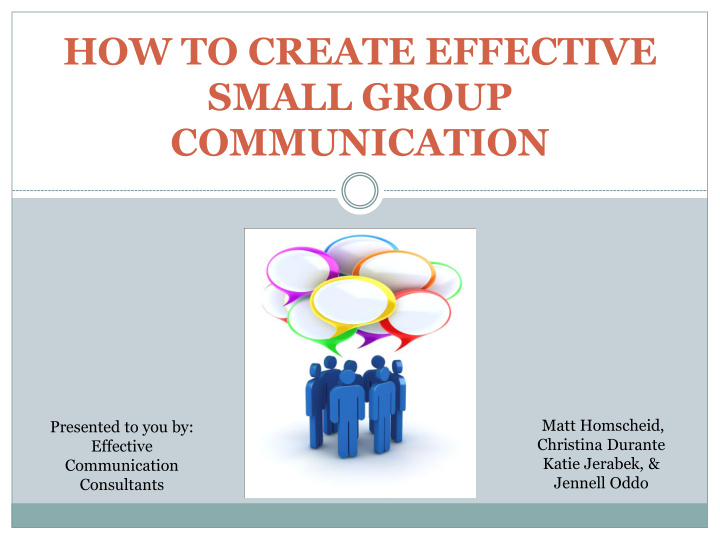



HOW TO CREATE EFFECTIVE SMALL GROUP COMMUNICATION Matt Homscheid, Presented to you by: Christina Durante Effective Katie Jerabek, & Communication Jennell Oddo Consultants
WHY ARE WE HERE TODAY? Who are our clientele and trainees? Why is our program necessary? What sets our program apart from other programs and will make clientele want to buy it? What will trainees learn from our program?
WHO ARE OUR CLIENTELE AND TRAINEES? Student Affairs offices at colleges and universities Over 9000 Resident Assistants across the United States Specifically, Head Residents and Resident Assistants Could be adapted in the future to include Resident Assistants in health care facilities or rehabilitation centers. Clientele are seemingly endless! PROFIT Benefits of program > Costs
WHY IS OUR PROGRAM NEEDED? Needs Analysis: “The biggest barrier is a lack of communication.” “If RAs can’t communicate with each other, they can’t provide the residents with the environment that they need.” “Not everyone on a ‘Res Life’ Staff can be a leader. There are times to lead, and there are times to listen. If staff members can’t do that, they can’t work effectively together.” Communication theorist Steven Beebe states that conflict ensues when group members cannot “negotiate group roles, establish goals, reveal similarities and differences, resolve conflict, and express affection.” (p. 110)
WHAT IS A SMALL GROUP AND WHY IS COMMUNICATION IMPORTANT? Small group communication is “communication among a small group of people who share a common purpose, who feel a sense of belonging to the group, and who exert influence on one another.” (Beebe & Masterson, 2009, p.3) Communication is important, especially amongst Residential Life staff members because: Provide safe environment for residents Effective methods to communicate messages Staff members work as a team
WHAT MAKES OUR PROGRAM THE BEST? Flexible approaches to each school with whom we work Preliminary Research, Interviews, Conversations Personality Tests Activities that allow trainees to work directly with their staff Follow-Up Websites Constant communication with clients, even after our program is presented Selling Strategy: Cheap, but effective Sample Videos & Handouts to continue training Personalized postcards and newsletters sent to clients periodically Phone Team
WHAT IS OUR MISSION? We’ve demonstrated the needs for our program. Improving small group communication is essential to providing a supportive environment in residence halls. Mission Statement: Through our program, we strive to build strong group cohesiveness through building listening skills and developing strong leaders who can take on different roles in a small group.
WHAT ARE OUR OBJECTIVES? Comprehension, Knowledge, Application, Evaluation Broke them into 3 Categories Cohesiveness, Listening, Leadership & Group Roles Examples: At the end of this program, trainees will be able to identify the needs of each member in their small group. Knowledge of William Schutz’s theory of inclusion, affection, and control At the end of this program, trainees will be able to identify listening barriers of communication and overcome them. At the end of the training program, trainees will be able to assess which roles need to be taken on in order to maintain effective communication and decision making within their staff. Kenneth Benne & Paul Sheats – Task & Maintenance Roles
WHAT WILL OUR PROGRAM ENTAIL? Group Cohesiveness “Many groups fail to remain together because they never identify their common purpose.” (Beebe & Masterson, 2009, p.5) Needs of members of a small group Inclusion, Affection, Control Group Analysis Activity Listening “Listening is crucial. If an RA doesn’t listen to what another RA is saying, conflict ensues and chaos follows. Good group communication start with listening to each other.” Barriers of listening Active Listening vs. Passive Listening Providing effective feedback Scenario Activity Leadership & Roles “If [group members] understand how group roles form and how various roles function, [they] will be better able to help a group achieve its purpose.” (Beebe & Masterson, 2009, p. 75) Different Types of Leadership Different Roles Task, Maintenance, Self-Centered Receive Personality Test Results
MC CONSULTING PHILOSOPHY Service to Clients Client centered training and consulting Total needs assessment Quality Products and Advice Maximum feedback with clients Continuous evaluation and improvement of services Mutual Support Teamwork is our motto Synergy is the result Profit based on Long-Term Relationships with Clients Feedback forms, preliminary research, updated websites for each client
WHAT DOES THIS ALL MEAN? “How to Create Effective Small Group Communication” + = for MC Consulting
Bibliography Beebe, Steven A. & Masterson, John T. (2009). Communication in small groups: Principles and practices. Boston: Pearson Education, Inc. Fantetti, Allison. Personal interview. 10 September 2012. Froemling, Kristin K., Grive, George L., & Skinner, John F. Communication: The handbook . Boston: Pearson Education, Inc. Kerr, Ryan. Personal interview. 10 September 2012. Nelson, Anders. Personal interview. 12 September 2012.
Recommend
More recommend